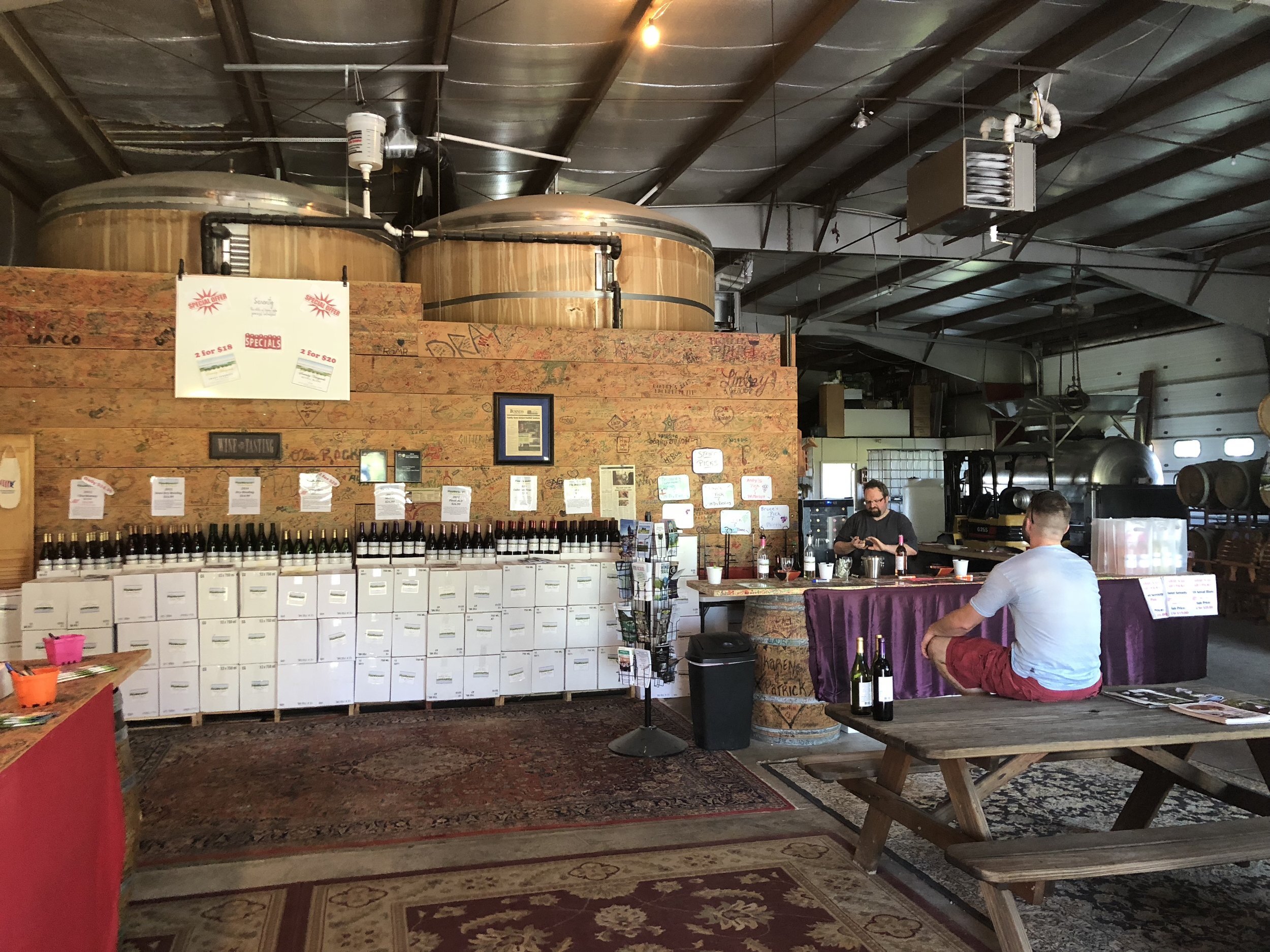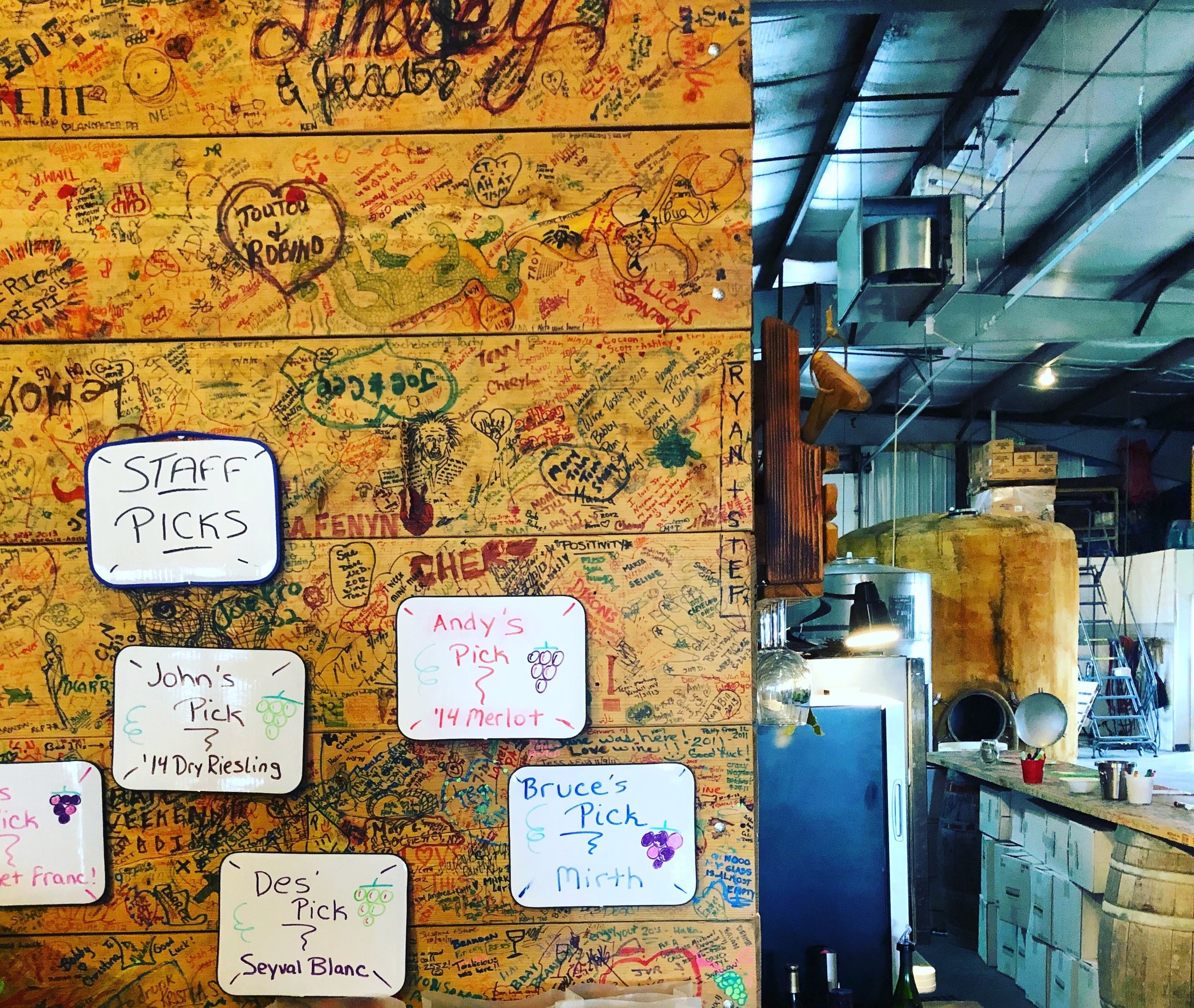Serenity Vineyards: Underdog and Overperformer
Originally posted on July 2, 2018 on The Vintner Project
A shorter writeup of Serenity was published on June 19, 2018 on Viniferoc
When you hear the name Serenity Vineyards, you likely imagine a tranquil interior with instrumental music and spa water by the door. Serenity Vineyards is not that place. It’s a very salt-of-the-earth establishment) serving outstanding wines that do not match it’s outward appearance as it’s essentially a warehouse. But that’s why I absolutely love it.
After an epic day of tasting some of the greatest wines coming from the west side of Seneca Lake, my boyfriend, Andy, and I rolled into Serenity 30-minutes before closing. With sheepish grins on our faces, we asked if we could do a tasting. The man behind the bar did not roll his eyes, but graciously pulled out two glasses and a menu and we got to work.
Two hours later, we found ourselves sampling estate-grown Chardonnay, Dry Riesling, and Seyval Blanc straight from the tanks (um, yes please and thanks). It’s this memory that I credit with turning me onto wines in a more professional fashion, and solidified Serenity Vineyards as one of the best.
Established in 1977, Serenity Vineyards sits on over 70 acres devoted to mostly dry vinifera, including Chardonnay, Riesling, Merlot, Cabernet Franc, and Pinot Noir. Serenity also grows hybrid grapes Sevyal Blanc and Cayuga. The bulk of the annual yield is sold as grapes or juice to wineries in the Finger Lakes and surrounding northeast region but a small (and very special) percentage is saved for Serenity’s personal production.
As it turns out, the man behind the bar was Bernard Cannac, the winemaker at Serenity Vineyards, and one of the most passionate people I’ve ever spoken to about wine. With over 20 years of experience, the Frenchman put his skills to work throughout New York State, first across 9 vintages (and several awards) in Long Island before before taking up residence at Heron Hill in 2010. Serenity’s 2015 acquisition of Bernard is a clear step towards setting them up for success. And Bernard is genuinely proud of the terroir, the maturity of the vines, and how the Finger Lakes micro-climates impact his fruits. Experiencing the wines is an almost artistic experience, as if he is trying to send a message to wine drinkers by painting the landscape within his barrels.
In a more recent visit, I became even more enamored with Bernard. We were tasting the 2015 Dry Riesling, which is one of three offered by the producer. Bottled from Block 5, this wine features 20% botrytis (or noble rot), and is the only one that went through a natural yeast fermentation. Bernard noted that “by late August, the berries looked like raisins, meaning a heavily concentrated flavor was on the way.” It immediately gives you hints of honeysuckle, wild flowers, and peach. There’s also a soft acidity that’s not overwhelming. It’s rich like a dessert wine, but somehow not sweet. As Bernard says, “this is a wine that made itself – I just watched it.”
In that comment, I realized the real thing that separates an amazing winemaker from the rest is knowing when to intervene and when to let the wines work on their own. A visit to Serenity will so you Bernard’s mastery and leave you wanting to hear and taste more. And so we did:
The 2014 Riesling is a fun comparison to taste after the ‘15 Dry. It’s vegetative, almost grassy, with dried apricots and maybe even a bit of petrol in there somewhere. It’s bright and fresh, highly acidic with a minerality that cuts through this colorful representation of the varietal. This is a perfect representation of Finger Lakes rieslings and how they thrive in the cold growing conditions of Upstate New York.
The 2016 Seyval Blanc features 41 year old vines. With a round mouthfeel, green apple, stone fruit (like apricot or peach) and a touch of citrus, you can truly taste the maturity in the glass. It feels like Sunday Funday in a bottle.
Andy and I love to explore how temperature affects wines with the 2013 Chardonnay. Aged in Hungarian Oak, when I think of Chardonnay, I think of this. It’s robust and nutty, with notes of olives, vanilla and toast. Take it out the fridge and let it warm up a bit - it’ll become loose (in the best way) and free.
The 2012 Pinot Noir shows you what a hot and dry year can do to the heartbreak grape (spoiler alert: great things). Aged in French oak, this wine is spicy with tobacco and a nice round mouthfeel. It’s ripe and exciting because when pinot works, it really works.
Depending on how you split or share your tasting, you’ll also enjoy the layered and rich 2015 Semi Dry Riesling, the very palatable 2014 Cabernet Franc, an exceptional 2014 Merlot (don’t let Sideways ruin you because yum), and the non-vintages of Sweet Serenity White and Sweet Serenity Pink, which are perfect summer sippers. Serenity offers self-guided tastings (wine flights you can enjoy on one of the picnic benches overlooking the stunning view of the lake), wine and cheese pairings, and wines by the glass.
Bernard seems particularly proud of the 2013 Mirth, a 50/50 Cabernet Franc/Merlot blend that can stand another 10 years in the bottle. He notes that “as wine ages, it gets less intense, but more complex. With blends, fruits mature at different rates. In the Mirth, you’ll taste more cab or more merlot depending on when you choose to enjoy.”
If you’re impatient like me, Bernard suggests decanting this wine for a few days. It’ll give you a sneak peek at what time will do to the wine over the course of 5-10 years...
...and then you’ll go back with that same sheepish grin Andy and I wore and buy a half case for your cellar.



